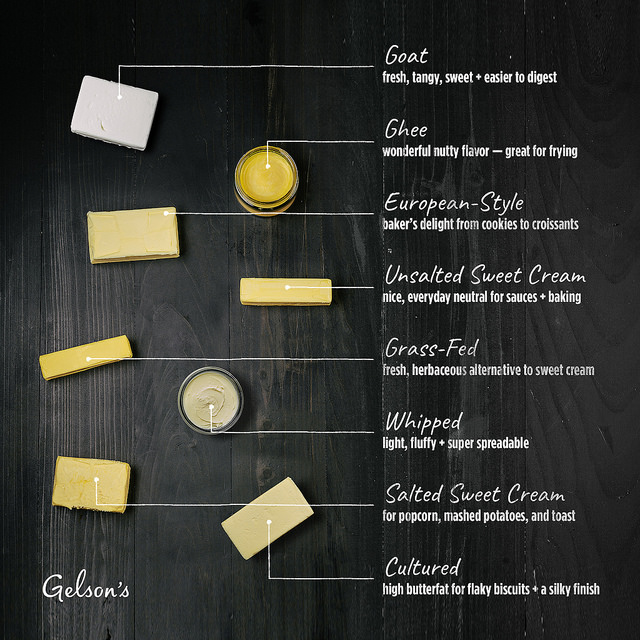Announcements
- Home /
- Announcements /
- A home cooks guide to butter
A Home Cooks Guide to Butter

If all the fats got together and held a popularity contest, butter would surely win hands down. Butter makes our baked goods tender, moist, and flaky. It pulls the flavors through our savory dishes. Our sauces are lush with it; our gravies thick. Most importantly, butter tastes wonderful — it gives our toast purpose.
And now is an especially thrilling time to be cooking and baking with butter. There are more butters than ever in our dairy case: Sweet, salty, cultured, European, goat, and ghee, just to name a few. Of course, while all that variety is inspiring, it can also be a little baffling. What’s the difference between all these butters, and what are we supposed to do with them?
Here’s a list of all the major butter categories we carry and how to put them to use in your kitchen. The good news, butter lovers and cooks, is that no one butter is perfect for everything, and every butter is special — so you might have to try them all.
Sweet Cream Butter — Salted and Unsalted
This is the butter most Americans have in their fridges. It’s made with sweet cream — meaning fresh pasteurized milk versus cultured (see below) — and per regulations, must be at least 80% butter fat.
In its salted form, it’s great for finishing stuff: melt it over popcorn, swirl it through your mashed potatoes — or drop a knob of it on your steak in the last minutes of cooking. If you’re baking or making a sauce, it’s better to use the unsalted variety because it gives you more control over flavor. With its high water content, it’s particularly good for choux pastry or cream puffs!
Grass-Fed Butter
Made from the milk of cows that feed on grass, this butter has a yellow hue that can vary in richness with the seasons — as the cows move from summer grass to winter hay. It has a fresh, pleasantly herbaceous flavor. Those grassy notes are harder to pick out once the butter is in foods, but if you’re making something like a beurre blanc, you may want to use a butter with a more neutral cream flavor.
Is grass-fed butter good for you? It may have higher levels of Omega 3 Fatty Acids than conventional sweet-cream butters, but you’d have to eat an awful lot of butter to match benefits of other sources, like fish, nuts, and seeds.
Ghee
Ghee is a rendered butter, meaning it’s cooked to remove the water and milk solids — leaving pure, golden butter fat with a wonderful nutty flavor. What’s the difference between ghee and clarified butter? Basically, the cooking processes are very similar, but clarified butter doesn’t brown, so it has a more neutral flavor.
Use ghee in your Middle Eastern and Eastern Asian dishes, like dal or curry, or for making butter sauces — like a lemony dip for lobster. It has a very high smoke point, so it’s also great for frying stuff. Bonus: It will keep in an airtight container in the cupboard for one month.
European-Style Butter
Although different countries and producers may have their own butter recipes, there is a consistent tradition throughout Europe: Butter is slowly churned until it achieves a butterfat content of at least 82 percent. It’s also allowed to ferment. This approach means that it melts faster, and it has a super rich, lightly tangy flavor and a soft texture.
For all those reasons, bakers prefer European-style butter. It makes cakes rise a little higher and pies flaky — and it gives laminated doughs, like croissants, a beautiful airy texture. The high butterfat also means less water, so it’s a good butter for pan searing a steak or a piece of fish.
Cultured Butter
A cultured butter is made either by allowing the cream to ferment or by adding live bacteria to it before it’s churned, much like yogurt. It often has a very high butterfat content, up around 86% depending on the producer. That gives it a silky mouthfeel and a rich, complex flavor — full of cream and yet slightly sour from the cultures.
Again, the high butterfat equals less moisture: This butter will make your biscuits flakier, your cookies crisper, and the crumb of your cake more tender. And, with all those cultures, it may also be easier to digest!
Goat Butter
Made with milk from goats, this butter has a similar fat content to sweet-cream butter, but is otherwise quite different. Goats don’t process their feed the same way cows do, so the butter is white, and it has a distinct flavor — it’s tart, like good yogurt, yet sweet and light. (One of our tasters called it dessert butter!)
It generally comes salted and it has a low melting point, so it’s nice and soft. Use it like you would salted sweet-cream butter. Goat butter is also a great alternative for people who are allergic to cow’s milk or lactose intolerant: It’s lower in casein and easier to break down and digest than cow’s milk.
Whipped Butter
Whipped butter has air or nitrogen gas whipped through it, which makes it soft and fluffy. It’s considered healthier because — what with all that air — there’s less fat per tablespoon. (And by law, whipped butter only has to be 25% butterfat.)
Whipped butter is too melty and foamy for cooking. It’s super power is spreadability, so it makes a great table butter — it’s not going to shred your toast! Serve it with muffins, baguettes, and sweet breads.